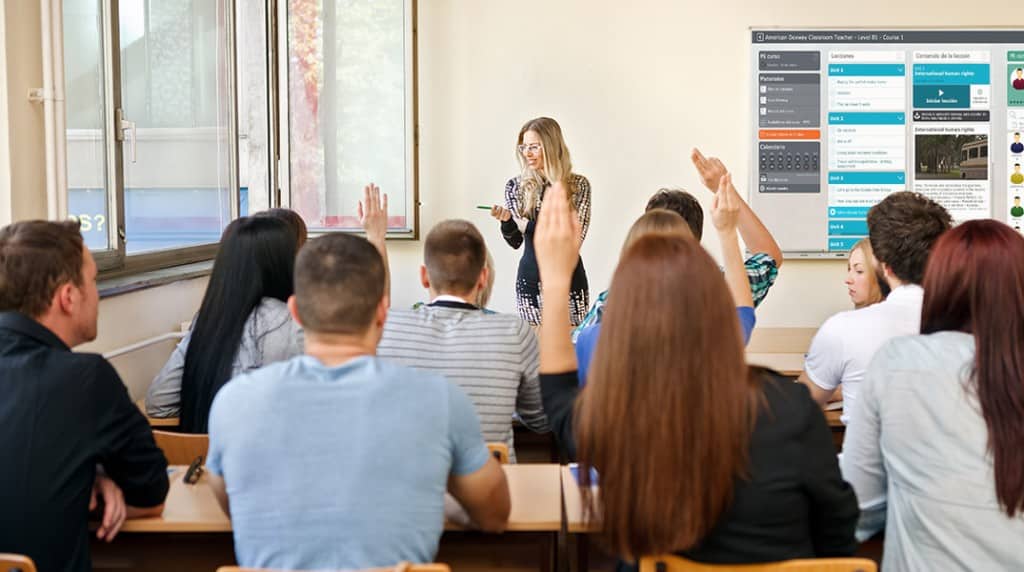The use of new technologies for language teaching has become the perfect complement for a comprehensive education that allows your students to achieve full English language proficiency. Language courses accompanied by e-learning solutions are more effective, flexible and attractive for students, especially for all those digital natives who are accustomed to using devices for most day-to-day tasks.
Whether you choose an online, blended or face-to-face methodology, an e-learning course will increase your students’ motivation and performance. Although the benefits are many, let’s review the five main advantages that ICT brings to language education.

Educational technology for English teachers to use in the classroom
Educational technology has changed the way teachers teach English in the classroom. They now have at their disposal a range of tools and resources that enhance the learning process. With interactive applications and online platforms, new possibilities are opening up to improve the effectiveness of learning for students, and their experience. Teachers can personalise learning, provide interactive multimedia resources, and foster communication and collaboration among students. In addition, technology facilitates their access to up-to-date information and the tracking of each student’s progress. Here are 5 benefits of educational technology:
#1 The best ally for teachers in the face-to-face classroom
In the classroom, teachers can now rely on different digital solutions that enrich traditional teaching. With educational technology, classes become more interesting, more immersive and fully interactive. Dexway In-Person, which is the Dexway face-to-face methodology, is perfect for secondary and high school levels. Covering levels A1 to B1, the teacher is provided with a curriculum fully adapted to their students’ needs, which they can follow from the digital whiteboard. Gamification, videos of real situations with native speakers, more than 20 types of exercises, readings and debates are some of the activities that Dexway In Person provides.
E-learning solutions also offer the possibility of switching to a blended learning method, or a flipped classroom, which have been proven to be successful. Both methods offer a hybrid methodology that favours flexibility and learner autonomy. Moreover, they provide teachers with an infinite number of exercises and activities for different levels, which promote student participation in the classroom.
#2 Technology is motivating and stimulating for students
The use of educational technology to learn English both inside and outside the classroom keeps students motivated. This is because nowadays students usually feel more comfortable using digital devices when learning a language, mainly due to tools such as voice recognition and interactive multimedia exercises. For young learners, it is significantly more stimulating to learn on a tablet or smartphone than to use a book.
Technology transforms students from passive recipients to active learners and allows more profound and enriching linguistic immersion.
Students complete their English course via comprehensive apps that work synchronously, and even without internet. Teachers can set lessons to be reviewed at home before class or allocate certain exercises as homework. But perhaps the most interesting thing for them is all the information that these applications can provide in real time.
Incorporating gamification in the classroom through educational platforms is another trigger for motivation. Being able to randomise participation and keep track of it, as well as assigning points and trophies to students according to their aptitude and attitude, are enjoyable ways to stimulate interaction in class.
#3 Ease in managing and monitoring student progress
Making and keeping lists of groups of students, managing courses, evaluating students with tests and exams, many tasks which are administrative in nature are these days managed thanks to online educational platforms which offer innumerable functionalities tailored to educational centres’ needs.
On one hand they allow educational institutions the best and most effective control over activities such as activating student accounts, creating groups, sending out communications and automatic notifications etc. On another hand important tasks such as monitoring the progress of students through software is now possible. Dexway has developed the Create Test function with allows teachers to design their tests, partially or fully, from a menu of questions in the database the same as he or she could create him/herself. Subsequently, after the students have taken these tests, they can be run through Dexway Analytics in order to obtain real time reports on the results of each course, lesson or objective. This way it can be seen if objectives have been attained in order to suggest activities or exercises to revise in the classroom.
Learning English in a classroom is much more effective when complemented with educational technology
#4 Create a unique experience as much for the teacher as the students
Using the flipped classroom method in English courses, together with complementary technology, transforms classrooms into an environment in which collaboration is optimal through sharing ideas, debating, and working on projects. It is a way to implement creative and participatory spaces. As a result, English classes become more motivating for students due to less teacher talking time, and in turn, student participation is encouraged.
The benefits of educational technology when teaching English are clear in terms of creating an experience that can be personalised for each student or group of students:
- Greater student involvement
- Better learning with virtual whiteboards
- Online exercises such as homework or reinforcement exercises
- Interactive multimedia content
#5 Promote interactivity and collaboration within learning
The use of new technology allows students to be much more creative and participative in the classroom. They prepare a basis of knowledge outside the classroom engaging with all the content in the course, when they arrive to the classroom they share this knowledge with the rest of the students and the teacher to demonstrate what they have learnt and reinforce it in a coordinated way. Educational technology allows students to be much better prepared for class, and provides teachers with attractive resources to make their classes much more human and sociable, where all students have the opportunity to participate regardless of their level.
When used alongside traditional teaching, new technology can differentiate between educational centres, taking English teaching one step further in paying attention to diversity in the classroom and enriching the language learning process.
You may also like:

